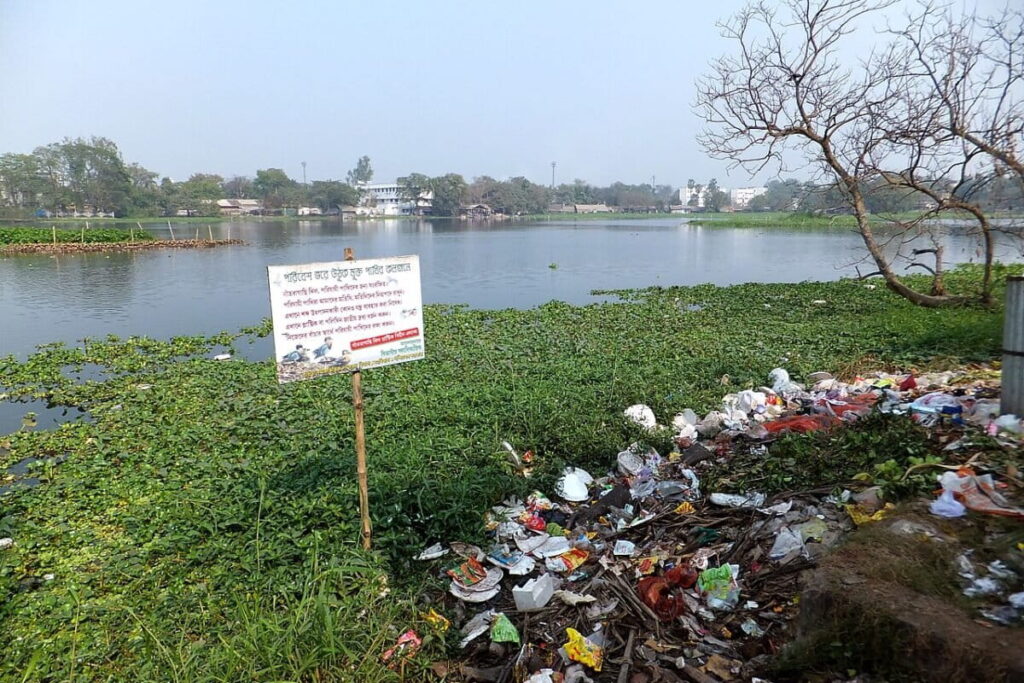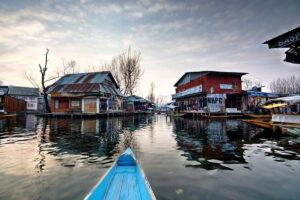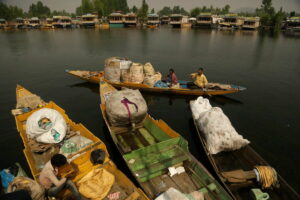How Excess Rains And Poor Wastewater Mgmt Send Microplastics Into City Lakes
Oct 30, 2025 | Pratirodh Bureau
Santragachi wetland in Howrah, West Bengal. Microplastic pollution in freshwater systems has emerged as a pressing environmental concern, yet efforts to prioritise key emission pathways remain limited (Image by Satabdi Datta via Wikimedia Commons)
- Continuous rainfall, stormwater runoff, wastewater treatment plants, littering zones and laundry sites transport microplastics to urban lakes.
- Microplastic pollution in freshwater systems has emerged as a pressing environmental concern, yet efforts to prioritise key emission pathways remain limited, researchers say.
- Climate change, which impacts rainfall events, is expected to aggravate the problem.
Weather conditions, especially continuous rainfall, drive microplastics into city lakes, a new study reports. Other major pathways include stormwater runoff, wastewater treatment plants, littering zones and laundry facilities.

A recent study on Dal lake in Srinagar looks at the routes that microplastics take to find their way into urban lakes. While microplastics contamination of freshwater systems is being widely reported as a pressing problem, there are only a few studies to explain how they could end up there. The amount of plastics entering freshwater systems is forecast to increase from an estimated range of 9-14 million tons in 2016 to approximately 23-37 million tons by 2040, according to a United Nations Environment Programme (UNEP) report.
The new pathway-specific risk assessment in Dal lake, published in Environmental Science: Advances, shows how microplastic properties are altered due to continuous rainfall in an urbanised lake; and how weather conditions, especially continuous rainfall, drive complex shifts in microplastic pollution patterns.
Previous studies mostly focused on quantifying microplastics in ambient surface waters (natural water bodies such as rivers and lakes), says Sudha Goel, professor at the department of civil engineering, Indian Institute of Technology, Kharagpur and one of the authors of the study. “Our study goes a step further by tracing the microplastic pollution back to its specific entry points,” she told Mongabay-India.
Goel’s team, which includes researchers from IIT, Kharagpur; National Institute of Technology, Srinagar and Institute for Water and Wastewater Treatment, Durban compared microplastic abundance and characteristics in Dal lake near wastewater outlets, open stormwater culverts, laundry sites and littering sites. “The results proved that each entry point has a unique fingerprint,” she says. For example, stormwater carried a distinct signature of black fragments resulting from tyre and road abrasions while wastewater and laundry sites are dominated by fibres.
Climate change concerns
Microplastic pollution in freshwater systems has emerged as a pressing environmental concern, yet efforts to prioritise key emission pathways remain limited, says Erath Shaji, a professor of geology at the University of Kerala, Thiruvananthapuram, who was not associated with the study. Targeting these pathways at their source is one promising strategy to mitigate microplastic pollution, he says. In Dal lake, continuous rainfall in this highly urbanised setting significantly influences microplastics dynamics.
The next important aspect of the study was to understand the effect of continuous rainfall which is becoming more frequent due to climate change, explains Goel. “The results were interesting as continuous rainfall not only increased the abundance of microplastics across pathways, but we also saw more hazardous polymers like poly vinyl chloride, polyurethane and acrylonitryl butadiene styrene (a thermoplastic) near stormwater outlets which significantly increased the toxicity of the lake water.”
There’s a critical climate change issue associated as well, says Goel. The year 2023 was the second warmest year on record in Asia and Europe; and more frequent and intense precipitation events are expected to increase due to the atmospheric water vapour concentration, she says. “Since we are not sure how resilient our existing wastewater treatment plants in India are to these extreme weather events, the increased load due to runoff may destabilise the conventional treatment processes resulting in increased microplastics load in the effluent.”
Additionally, given the littering and mismanaged waste in the country, “we can expect the microplastic pollution in our freshwater bodies to become more severe and complex in coming years which indicates a pressing need for timely action,” she cautions.
The Dal lake study “offers a nuanced perspective on urban freshwater systems” by integrating ecological data, socio-economic indicators and stakeholder perceptions, says Shaji. Many studies identify key drivers such as rapid urbanisation, population growth, pollution, agricultural expansion, invasive species, and inadequate management as significant pressures on the lake’s ecological integrity and socio-economic dynamics, he says. “The (IIT Kharagpur) study highlights the vulnerability of microplastics in Dal Lake to both current and future disruptions, highlighting the necessity of adaptive management strategies to enhance its resilience,” says Shaji.
India’s urban lakes at risk
“While comprehensive nationwide monitoring is still needed, our study, along with other recent reports indicates that microplastic pollution is a pervasive and significant problem for Indian urban lakes,” says Goel. “We did a comparative analysis to see the extent of pollution of Indian urban lakes with other lakes around the world and the literature suggests that Indian lakes are more polluted than lakes in other countries. This is mainly because of inadequate waste management infrastructure in India, limited public awareness and education on issues associated with plastic waste, very limited resources, and littering.”

For example, the average microplastic abundance observed in Dal lake was higher than reported studies from Saimaa lake in Finland, and Ontario lake in Canada, her team’s report says. However, when compared with studies from Asia, the abundance was within the range observed in urban lakes, especially from developing countries. These include Renuka lake and Kumaraswamy lake in India; and Rawal lake in Pakistan. The higher abundance of microplastics in these countries can be attributed to a combination of factors, including inadequate waste management infrastructure, limited public awareness and education, poor legislation, finite resources, and mismanagement of waste, the report says.
Urban lakes such as Dal lake are particularly vulnerable because these are located in densely populated areas with high tourism throughout the year, says Goel. Due to inadequate waste management and stormwater infrastructure, urban lakes act as a sink, concentrating pollution from the entire catchment, she says.
Urban lakes are also particularly vulnerable because the problem isn’t just in surface water but also in the sediments which can store microplastics and become a source again during heavy rainfall, creating a persistent cycle of pollution, adds Goel. “Therefore, any urban lake in India with similar anthropogenic pressures is likely to be facing a comparable, if not worse, scenario.”
Microplastic pollution in India’s urban lakes is a huge and growing concern, agrees Shaji. Studies across multiple regions, including Vellayani lake in Thiruvananthapuram, Chennai lakes and Dharapadavedu lake in Tamil Nadu, and Dal lake in Jammu and Kashmir, have documented significant concentrations of microplastics in both water and sediments, with fibres and fragments of polymers like high-density polyethylene (HDPE), polypropylene (PP), polyethylene terephthalate (PET), and low-density polyethylene (LDPE) being the most common.
A separate study by Shaji’s team provides critical insights into the prevalence and characteristics of microplastic pollution in Vellayani Lake, representing one of the earliest investigations into microplastic contamination in freshwater lakes in southern India.
The study identified the presence of microplastics in water samples collected from three locations within the lake. The average microplastics concentrations were higher during the monsoon season compared to summer. These findings are particularly concerning given that Vellayani lake serves as a major drinking water source for thousands of people in the region, underscoring the urgent need for effective waste management strategies and pollution control measures to safeguard public health and the environment, says Shaji.
Similarly, a study by S. Mahenthiran, an associate professor at the School of Civil Engineering at Vellore Institute of Technology, on microplastic pollution in Dharapadavedu lake in Vellore shows moderate to high microplastic contamination levels in both the water and the sediments. The study also discusses the role of human activity in microplastic pollution, and the necessity of improving waste management and pollution control measures to protect the lake ecosystem.
Improving regulation, tech and awareness
Reducing microplastic pollution in India’s urban lakes, including Dal lake, requires a combination of technological, regulatory, and community-driven interventions, says Shaji. This includes promoting plastic waste segregation at the source, recycling and reducing single-use plastics. Also required are upgrading wastewater treatment plants and implementing stormwater filtration systems.
Nature-based solutions, such as restoring wetlands and riparian buffers, along with adaptive management of lakes, help trap microplastics and enhance ecological resilience, says Shaji.
Regular monitoring and research are essential to identify hotspots and guide interventions, and community engagement ensures sustainable behavioural change, he says. At the national level, a comprehensive policy framework, integrating Extended Producer Responsibility (EPR), urban planning regulations, industrial effluent standards, and coordinated monitoring programmes, can provide guidance and enforcement to mitigate microplastic pollution across urban freshwater systems in India.
In addition to these, Mahenthiran suggests adopting stormwater management techniques such as filtration systems around lake areas where water flows into the lake, raising public awareness and promoting plastic-free lifestyles as alternative solutions. Additionally, strict regulations on plastic use and promoting eco-friendly alternatives can be a possible solution to tackle microplastic pollution in lake ecosystems, he says. “Initiating certain public engagement programmes, like social media awareness campaigns to raise awareness about the impact of microplastics in lakes, and regular monitoring of microplastics in lake ecosystems would help track pollution trends and mitigate them.”
(Published under Creative Commons from Mongabay India)
